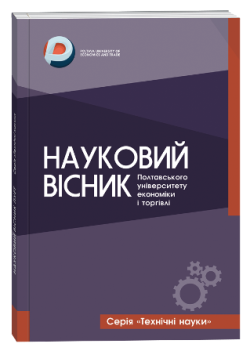STUDY OF THE INFLUENCE OF NITROGEN-CONTAINING COMPOUNDS ON THE PHYSICOCHEMICAL AND ORGANOLEPTIC CHARACTERISTICS OF WHITE TABLE WINE MATERIALS
Abstract
Ukraine is one of the few countries that practices viticulture on soils rich in nutrient organic compounds, which leads to the accumulation of excessive amounts of nitrogen-containing substances in grapes and, consequently, in must. For this reason, the management of these compounds in vineyards and in subsequent wine production is one of the key directions of modern research. The purpose of this work is to study the effect of different concentrations of amino nitrogen in must on the fermentation process and the formation of compounds that shape the organoleptic profile of white table wine materials, particularly in varieties with high phenolic content. The research materials included grapes, fermenting must, and wine materials from the varieties Sukholimanskyi Bilyi, Riesling Rhein, and Muscat Odeskyi. The results of studies of nitrogenous compounds in grapes and wine materials showed that the mass concentration of amino nitrogen in grapes averages 280 mg/dm³, which is more than sufficient for the normal nutrition of yeast during fermentation. Arginine and proline constitute the highest percentage among amino acids and are indicators of the ratio of assimilated and non-assimilated nitrogen by yeast. It has been established that Riesling Rhein is a proline-accumulating variety, while Muscat Odeskyi and Sukholimanskyi Bilyi are arginineaccumulating varieties. Studies confirmed that the use of the "sur lie" technology positively affects the stability of linalool in the aromatic complex of wine materials obtained from Sukholimanskyi Bilyi and Riesling Rhein grapes. In the wine materials from Muscat Odeskyi grapes, storage on fine lees led to a decrease in the mass concentration of linalool compared to those obtained using the "sur lie" technology. Aging wine materials on lees contributes to the preservation of aromatic components and positively affects the sensory characteristics of wine materials. The obtained results allowed the development of recommendations for the production of white table wine materials based on the management of nitrogenous compounds.
References
2. Osnovni metody tekhnokhiminchoho kontroliu pry vyrobnytstvi vyn: Metodychnivkazivky ta instruktsiia do laboratornoho praktykumu z dystsypliny «Khimiia ta biotekhnolohiia vyna» dlia studentiv spetsialnosti «Kharchovi tekhnolohii» / Ukl.: D.B. Kichura, B. O. Dziniak. Lviv: Vydavnytstvo Natsionalnoho universytetu «Lvivska politekhnika», 2021 [in Ukrainian].
3. Ana Gonzalez-Marco, Nerea Jimenez-Moreno, Carmen Ancin-Azpilicueta. Influence of nutrients addition to nonlimited-in-nitrogen must on wine volatile compounds. Journal of Food and Science. 2010. V. 75. № 4. P. 206–211.
4. A.P. Stines, J. Grubb, H. Gockowlar, P.A. Henschke, P.B. Hoj, R. van Heeswijck. Proline and arginine accumulation in developing berries of Vitis vinifera L. in Australian vineyards: Influence of vine cultivar, berry maturity and tissue type. Australian Journal of Grape and Wine Research. 2000. 6. P. 150–158.
5. E. Dimitriadis, P. J. Williams. The Development and Use of a Rapid Analytical Technique for Estimation of Free and Potentially Volatile Monoterpene Flavorants of Grapes. Am. J. Enol. Vitic. 1984. V. 35. №. 2. P. 66–71.
6. DSTU ISO 5495:2005 Doslydjennya sensorne. Metodologiya. Metod parnogo porivnyannya. Vidpovidae ISO 5495:1983, IDT. Chynnyi vyd vid 2006-07-01. – Kyiv: Derjspojyvstandart, 2006. 7 с. [in Ukrainian].
7. P. Herbert, P. Barros, N. ratola, A. Alves. HPLC determination of Amino acids in musts and port wine using OPA/FMOC derivatives. Journal of Food Science. 2000. V. 65. №. 7. P. 1130–1133.
8. P. Ribereau-Gayon, A. Maujean, D. Dubourdieu. Handbook of Enology. Volume 2: The chemistry of wine and stabilization and treatements. 2006. John Wiley & Sons, Ltd. P. 109–139.
9. Sally-Jean Bell, Paul A. Henschke. Implications of nitrogen nutrition for grapes, fermentation and wine. Australian Journal of grape and wine research. 2005. 11. P. 242–295.
10. S.E. Spayd, R.L. Wample, R.G. Evans, R.G. Stevens, B.J. Seymour, W. Nagel. Nitrogen fertilization of white Riesling grapes in Washington. Must and wine composition. Am. J. Enol. Vitic. 1994. V. 45. №. 1. P. 34–41.
11. Lonvaud-Funel A. & Joyeux A., Histamine production by wine lactic acid bacteria: isolation of a histamineproducing strain of Leuconostoc oenos, 1994, Journal of Applied Bacteriology, 77: 401-407.
12. X. Chone, Valerie Lavigne-Cruege, T. Tominaga, C. Van Leeuwen, C. Castagnede, C. Saucier, D. Dubourdieu. Effect of vine nitrogen status on grape aromatic potential: flavor precursors, glutathione and phenolic content in Vitis Vinifera L. cv. Sauvignon Blanc grape juice. J. Int. Sci. Vigne Vin. 2006. V. 40. № 1. P. 1–6.


